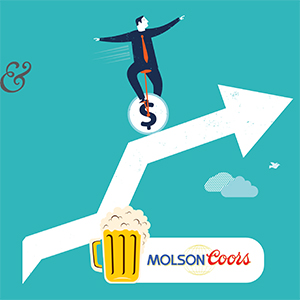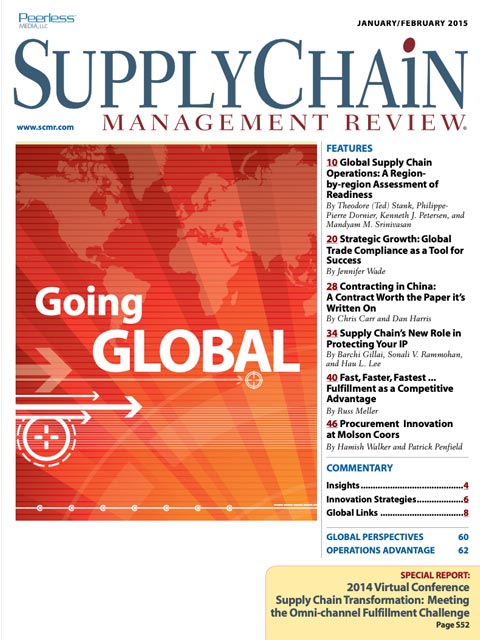Sorry, but your login has failed. Please recheck your login information and resubmit. If your subscription has expired, renew here.
January-February 2015
As long as there have been boats and beasts of burden, intrepid business professionals, governments, and marauders have sought fame, fortune, wealth, and value by going global. Think the Phoenicians, Marco Polo, and the Vikings in days of old. Or in contemporary times, think of China, BRIC, EMEA, and other emerging markets. One could argue that outsourcing to China a few decades ago gave birth to supply chain management as we think of it today. This month we’re including an online bonus column from APQC. While this issue focuses on global management, we didn’t want to miss out on the column. Browse this issue archive.Need Help? Contact customer service 847-559-7581 More options
Innovate, innovate, innovate. That could be the mantra for business today, as the battle to be first to market with a new product intensifies. Regardless of the industry, companies are launching new products and extensions of existing products at a dizzying pace. Every facet of the organization is under pressure to come up with new ideas.
In many businesses, product innovation is driven through the marketing and engineering departments. However, several progressive organizations are now driving innovation through their procurement groups. Top management is tasking these purchasing organizations to tap into the expertise of their supply base to collaborate on the development of new product opportunities. This is a different way of thinking about procurement that requires new processes and a structure to support innovation. Can all companies move down this innovation path? And if so, what processes should be employed to help purchasing professionals drive innovation from their supply base?
Those are questions asked—and answered—every day in the procurement organization at Molson Coors Brewing Company. This is the story of how we implemented a five-step process to drive procurement innovation.
Building on a History of Product Innovation
Product innovation is as central to Molson Coors’ culture as the Rocky Mountains. In 1959, Bill Coors and his team developed the first recyclable aluminum beer can. This innovation reduced packaging waste and also allowed beer cans to be recycled. Coors also made this innovation available to the rest of the beverage world. Today, Molson Coors continues that tradition of innovation through its cold activated bottle and cans, vented can ends and other aluminum packaging innovations, as well as multiple new flavors and styles of beer.
 |
This complete article is available to subscribers
only. Click on Log In Now at the top of this article for full access. Or, Start your PLUS+ subscription for instant access. |
SC
MR
Sorry, but your login has failed. Please recheck your login information and resubmit. If your subscription has expired, renew here.
January-February 2015
As long as there have been boats and beasts of burden, intrepid business professionals, governments, and marauders have sought fame, fortune, wealth, and value by going global. Think the Phoenicians, Marco Polo, and… Browse this issue archive. Access your online digital edition. Download a PDF file of the January-February 2015 issue.
 |
Download Article PDF |
Innovate, innovate, innovate. That could be the mantra for business today, as the battle to be first to market with a new product intensifies. Regardless of the industry, companies are launching new products and extensions of existing products at a dizzying pace. Every facet of the organization is under pressure to come up with new ideas.
In many businesses, product innovation is driven through the marketing and engineering departments. However, several progressive organizations are now driving innovation through their procurement groups. Top management is tasking these purchasing organizations to tap into the expertise of their supply base to collaborate on the development of new product opportunities. This is a different way of thinking about procurement that requires new processes and a structure to support innovation. Can all companies move down this innovation path? And if so, what processes should be employed to help purchasing professionals drive innovation from their supply base?
Those are questions asked—and answered—every day in the procurement organization at Molson Coors Brewing Company. This is the story of how we implemented a five-step process to drive procurement innovation.
Building on a History of Product Innovation
Product innovation is as central to Molson Coors’ culture as the Rocky Mountains. In 1959, Bill Coors and his team developed the first recyclable aluminum beer can. This innovation reduced packaging waste and also allowed beer cans to be recycled. Coors also made this innovation available to the rest of the beverage world. Today, Molson Coors continues that tradition of innovation through its cold activated bottle and cans, vented can ends and other aluminum packaging innovations, as well as multiple new flavors and styles of beer.
 |
SUBSCRIBERS: Click here to download PDF of the full article. |
SC
MR


Latest Supply Chain News
Latest Podcast

 Explore
Explore
Latest Supply Chain News
- AdventHealth named top healthcare supply chain by Gartner
- Geopolitical readiness in supply chains: Strategic challenges for leaders
- Unlocking retention: The role employee engagement plays
- Can supply chain managers embrace an entrepreneurial mindset?
- Challenges to ESG reporting
- With capacity to spare, logistics real estate demand remains subdued
- More latest news
Latest Resources

Subscribe

Supply Chain Management Review delivers the best industry content.

Editors’ Picks





